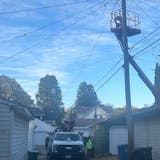In a door-knocking sweep reminiscent of the movie "Erin Brockovich," officials in Randall, Minn., visited every household in town last month, warning families about poison in their water supply.
Exceedingly high nitrate levels had turned up in one of Randall's two municipal wells, and all 637 people in the north-central Minnesota community received boldface notices that infants were at risk of a potentially fatal blood condition. The well was no good, they learned, and the town would have to buy a new one.
"I was shocked," said Joseph Ellis, a Randall resident. "We don't drink this water anymore."
Randall's water emergency is the latest sign of an environmental problem in Minnesota. Nitrogen fertilizer is leaching into groundwater from farm fields, contaminating wells and costing taxpayers millions of dollars a year. Sixteen communities have violated the state health limit for nitrates, and half have installed expensive nitrate-removal systems at a cost per household of $3,300 or more.
Communities are spending even more money to keep local nitrate levels in check. More than 45 of them are working with the state Department of Health to slow or reverse nitrate pollution in their public water systems, including towns that bought out nearby farmers to remove cropland from atop their well fields.
In addition, the Health Department annually finds violations of the nitrate standard in "non-community" well systems like schools, resorts and highway rest areas. Last year alone, 14 of those places exceeded the nitrate limit.
In about one community a year, as in Randall, mitigation efforts fail.
"It's frustrating, but it's become part of the cost of operation," said Pete Moulton, public works director in St. Peter, one of the eight communities running nitrate-removal plants.


